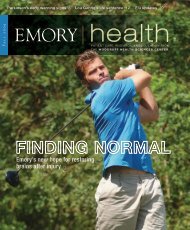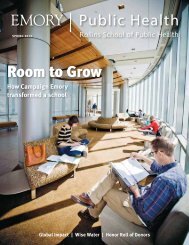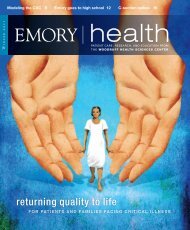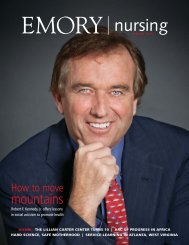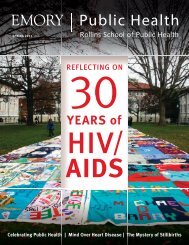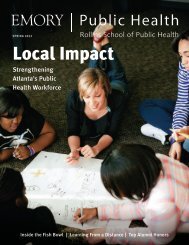Public Health Magazine - Fall 2008 - Woodruff Health Sciences ...
Public Health Magazine - Fall 2008 - Woodruff Health Sciences ...
Public Health Magazine - Fall 2008 - Woodruff Health Sciences ...
You also want an ePaper? Increase the reach of your titles
YUMPU automatically turns print PDFs into web optimized ePapers that Google loves.
Following aid Atlanta, Thurman<br />
served with the Task Force for Child<br />
Survival and Development and then<br />
directed the office of National aids<br />
Policy in the Clinton White House.<br />
When Clinton left office, many of<br />
the aids programs were shifted to<br />
iat, led by Thurman in Washington<br />
and now at the rsph.<br />
Blount supported Thurman each<br />
step of the way and even encouraged<br />
her to go back to school to get a<br />
theology degree.<br />
“When I started my work in hiv/<br />
aids as a hospice volunteer, I learned<br />
that it’s impossible to separate<br />
people’s health from their spiritual<br />
life,” says Thurman. “What sustains<br />
people in times of challenge, particularly<br />
around end-of-life issues<br />
and chronic illness, is their faith. So<br />
much of Joe’s generosity is grounded<br />
in the tenants of his faith. We resonate<br />
in that way.”<br />
When Thurman returned to<br />
Atlanta with iat, she and Blount<br />
began to discuss the possibility of an<br />
endowment to support her ongoing<br />
work on hiv/aids and the connection<br />
between faith and health. The<br />
$2 million gift, creating the Joseph<br />
W. Blount Global <strong>Health</strong> and Society<br />
Program, was formalized earlier<br />
this year.<br />
With Blount’s support and Thurman’s<br />
direction, the Global <strong>Health</strong><br />
and Society Program will focus<br />
on challenges faced by the world’s<br />
most underserved populations. Its<br />
work will encompass faith and<br />
health, hiv/aids, women’s health,<br />
health advocacy, and the empowerment<br />
of women and girls. The goal:<br />
coming to understand the social<br />
drivers of disease and disparities to<br />
help communities address issues in<br />
their own backyards.<br />
In many poor places in the world,<br />
that means working through the<br />
church or other faith-based institutions,<br />
which together provide more<br />
than 40% to 60% of all health care<br />
and social services.<br />
ihp, a cornerstone of the Global<br />
<strong>Health</strong> and Society Program, works<br />
“What sustains people<br />
in times of challenge<br />
is their faith.”<br />
—Sandra Thurman, director,<br />
Interfaith <strong>Health</strong> Program<br />
with faith-based institutions, nongovernmental<br />
organizations, governments,<br />
and religious and political<br />
leaders to assess public health needs<br />
and resources in communities.<br />
Working with those communities,<br />
ihp then helps develop health, education,<br />
and support services that fit<br />
the people they serve.<br />
At the same time, Thurman works<br />
to empower people who have the<br />
resources to help more effectively.<br />
For the past five years, she has taken<br />
women philanthropists to Africa to<br />
see the disproportionate impact of<br />
the aids epidemic on women and<br />
girls. After introducing her visitors<br />
to first ladies, ministers of health,<br />
and other women leaders, Thurman<br />
leads her guests to various sites,<br />
such as microenterprise programs<br />
that bring women out of poverty or<br />
orphanages and homes for children<br />
affected by aids, to demonstrate<br />
how appropriate investments can<br />
make a difference.<br />
Just recently, the ihp began<br />
working with the U.S. President’s<br />
Emergency Plan for aids Relief on<br />
prevention programs in Kenya. ihp<br />
also joined forces with the cdc to<br />
create the first National Center for<br />
<strong>Public</strong> <strong>Health</strong> and Faith Collaborations<br />
(ncphfc). The ncphfc works<br />
with more than 13,000 partners<br />
worldwide, including more than 125<br />
congregations with health missions<br />
in East and Southern Africa.<br />
“our goal is to teach—and share—<br />
the basics of public health, the basics<br />
of development, and the basics of<br />
engaging with people in resourceconstrained<br />
settings,” says Thurman.<br />
“our curriculum builds on community<br />
wisdom from Africa and other<br />
global settings and is designed, in<br />
part, to train people in U.S. congregations<br />
to be more effective when they<br />
go overseas and spend time on the<br />
ground in the developing world.”<br />
Though the fight against aids has<br />
seen some victories, with a reduction<br />
in new infections in Africa, Thurman<br />
is the first to admit that there<br />
is yet a long way to go. “What Joe<br />
and I have begun, we will not see<br />
the end of,” says Thurman. “But we<br />
are both committed to building a<br />
foundation that will foster the necessary<br />
research and conversations so<br />
the kind of interventions that really<br />
make a difference can be built. I’m<br />
talking about interventions based on<br />
science and reality, not ideology.” <br />
fall <strong>2008</strong> public health magazine 19



